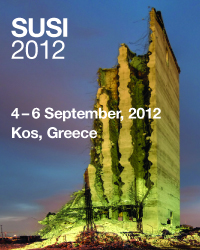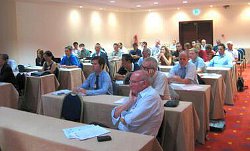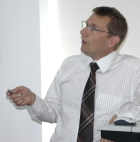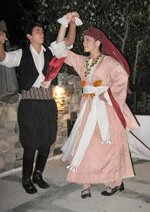SUSI 2012
12th International Conference on Structures Under Shock and Impact 2012
4 - 6 September 2012
Kos, Greece
Overview

The 12th International Conference on Structures Under Shock and Impact (SUSI12) took place in Kos, Greece organised by Wessex Institute of Technology with the collaboration of the University of Liverpool, both of the UK.
The Conference Honorary Chairman was Professor Norman Jones, member of the Royal Society. The other Co-Chairmen were Professor Carlos A Brebbia of Wessex Institute and Dr Graham Schleyer of the University of Liverpool. The Conference was sponsored by the International Journal of Computational Methods and Experimental Measurements, and the papers published in a volume of the WIT Transactions on the Built Environment which are available at WIT Press, online library (http://library.witpress.com/).
The objective of the meeting was to attract participants from a broad spectrum of expertise from academia and industry, working with structures which are subjected to impact and blast loadings.
The shock and impact behaviour of structures is a challenging area, because of the difficulties of representing very specifically time dependent phenomena, the need to specify the appropriate dynamic loadings and the differentiation of the full dynamic properties of materials.
A substantial amount of research continues to be carried out regarding the simulation of structures under shock and impact and the validation of the results through experiments. The field and the range of topics considered continue to grow.
The conference started in Cambridge, Massachusetts as early as 1989 continues to be an important focus for all researchers working in this area, particularly because of the permanent evolution of the topics under consideration.
The meeting was opened by Carlos who referred to the importance of the conference with the programme of meetings organised by the Wessex Institute. He reminded the audience of the success of the meeting as demonstrated by the support of the community for nearly a quarter of a century. The Conference, Carlos said, has been convened as follows:
-
1989 Cambridge (USA)
 Delegates at the Conference
Delegates at the Conference - 1992 Portsmouth (UK)
- 1994 Madrid
- 1996 Udine
- 1998 Thessaloniki
- 2000 Cambridge (UK)
- 2002 Montreal
- 2004 Crete
- 2006 New Forest (UK)
- 2008 The Algarve
- 2010 Tallinn
Carlos thinks that the SUSI Conference has been one of the most successful in the WIT series due to the quality of the presentations, and the high level of discussions. WIT, Carlos explained, aims to disseminate knowledge through the organisation of advanced meetings, as well as publications, courses and research.
Most of the research activities at WIT focus on the development of novel computational techniques and the Institute has participated as a partner in many international projects. Funds from the projects support research fellowships and associates.
Carlos explained that the WIT Campus is the New Forest has up to date accommodation and other facilities, including an indoor swimming pool. The emphasis is in improving the quality of our environment – Carlos stressed – rather than aiming for a large number of researchers.
WIT specialisation in the field of Boundary Elements and the Mesh Reduction Techniques has resulted in numerous new developments, many of which have been implemented in engineering practices.
Current research work at WIT in this field concentrates on the modelling of infinite fields and the study of fractured mesh propagation.
Opening Address & Conference Topics

Graham also referred to the importance of defining better material characterisation properties. He described several tests carried out on plates with holes as an illustration. The problem was solved experimentally and also by computer simulation as fluid structure, interaction problems. The case illustrates the importance of the interaction between experiments and numerical simulation. In this case that interaction pointed to interesting and unexplained effects including the importance of the hole shape in the results.
The conference papers covered a series of important topics amongst them, ie
- Impact and blast loading
- Structural crashworthiness
- Interaction between computational and experimental results
- Hazard mitigation
- Response of building facades to blast
- Energy absorbing issues
- Response of reinforced concrete under impact
- Aeronautical and aerospace applications
- Seismic behaviour
Invited Papers
The papers which can be seen in WIT’s elibrary (http://library.witpress.com/) includes a number of keynote addresses given by renowned specialists, ie
‘Transient pressure loading of clamped metallic plates with pre-formed holes’
by G Schleyer, University of Liverpool, UK
‘Impact loading of square plates with piece wise constant thickness’
by J Lellop, University of Tartu, Estonia
‘High explosive thermodynamic equations of state for combined fragmentation and blast loading’
by E L Baker, US Army ARDEC, USA
‘Nonlinear dynamic response of RC building facade panels to impact loading’
by M Abdel-Mooty, American University of Cairo, Egypt
‘Blast resistant design and limits of the response of a structure to an external explosion’
by D Makovicka, Czech Technical University, Czech Republic
‘Rim release: impact of aircraft wheel flange fragment on wing flap mechanism’
by S Heimbs, European Aeronautic Defence and Space Company, Germany
Special Session
A special seminar was organised by Professor M Abdel-Mooty of the American University of Cairo on ‘Response of building façade and components to blast and load’. It consisted of his own keynote address as above, plus the three following papers:
- Progressive Collapse Analysis of High-Rise Building Considering the Effect of Outrigger-Belt Lateral Load Resisting System
- Investigating Projectile Penetration of Sandwich Panels with Multiple Suppressive Cores
- New developments in a blast protection solution made of laminated polycarbonate for building facades
ISAC & Conference Dinners

There were numerous occasions for the delegates to interact outside the conference room, including refreshment breaks, conference lunches and the banquet that took place one evening in a traditional restaurant, located in a picturesque mountain villa from the terrace of which it was possible to appreciate the sunset.
The menu included some local specialities and in particular the oven baked meats for which the restaurant is renowned. The food was accompanied by good local wines and the dinner ended with sweets and a glass of raki.
During the meal a group performed island dances and persuaded some of the most energetic delegates to join them, contributing to the enjoyment of the occasion.
Conference Proceedings
The proceedings of SUSI, 412pp (Print ISBN: 978-1-84564-612-7 eISBN: 978-1-84564-613-4) are available from WIT Press. Orders can be placed on the WIT Press web site at www.witpress.com or by email: This email address is being protected from spambots. You need JavaScript enabled to view it., telephone: +44 (0) 238 029 3223 or fax: +44 (0) 238 029 2853.
Papers from the conference will also be hosted online at the WIT eLibrary as Volume 126 of WIT Transactions on the Built Environment (ISSN: 1746-4498, Digital ISSN 1743-3509). For more details visit the WIT eLibrary at http://library.witpress.comRelated Conferences
Associated conferences are:- Materials Characterisation, 4-6 June 2013 to be held in Siena, Italy (see here, http://www.wessex.ac.uk/13-conferences/materials-characterisation-2013.html)
- Contact & Surface, 5-7 June 2013 to be held in Siena, Italy (see here, http://www.wessex.ac.uk/13-conferences/contact-and-surface-2013.html)
- ERES, 8-10 July 2013 to be held in A Coruna, Spain (see here, http://www.wessex.ac.uk/13-conferences/eres-2013.html)
- SAFE, 17-19 September 2013 to be held in Rome, Italy (see here, http://www.wessex.ac.uk/13-conferences/safe-2013.html)


 Wessex Institute
Wessex Institute